#Amin Nawabi
Explore tagged Tumblr posts
Photo
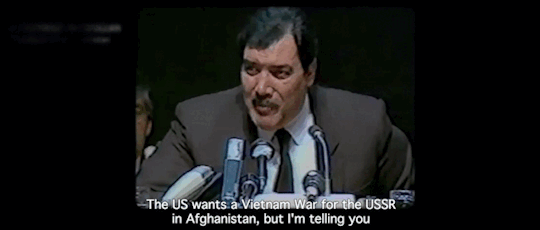
Flugt [Flee] (Jonas Poher Rasmussen - 2021)
#Flugt#Flee#drama film#Denmark#Afghanistan#refugees#Jonas Poher Rasmussen#European cinema#Riz Ahmed#life#Nikolaj Coster-Waldau#Amin Nawabi#2020s movies#history#war in Afghanistan#European society#self-discovery#talibans#unaccompanied minor#life story#Copenhagen#gay marriage#withdrawal of US troops#US defeat#Kabul#Joe Biden#2021#US–Taliban deal#CIA#Antony Blinken
7 notes
·
View notes
Text
DVD review: “Flee” (2021)
“Flee” (2021) Documentary Running Time: 90 minutes Written by: Jonas Poher Rasmussen and Amin Nawabi Directed by: Jonas Poher Rasmussen Amin (9-11 years old): “We have no idea what’s going to happen. to us. Nobody tells us anything. The journalists come and film us. We hope something will happen, but no. They go home to make TV programmes… But nothing really happens. It’s just us and the…
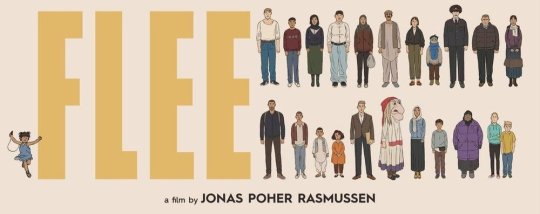
View On WordPress
#Amin Nawabi#dvd#dvd documentary#dvd new zealand#dvd review#DVD reviews#DVDReviews#flee#flee dvd#flee dvd review#Jonas Poher Rasmussen
0 notes
Text
Nimona Spoiler-Filled Review [part 1]
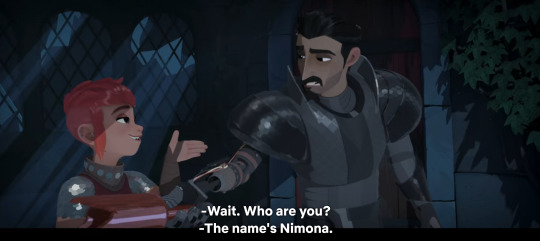
Nimona is a science fantasy adventure-comedy film. It is based on ND Stevenson's webcomic, and later graphic novel, of the same name. Annapurna Animation, Vertigo Entertainment, DNEG Animation, Blue Sky Studios, and 20th Century Animation produced the film. Nick Bruno and Troy Quane directed it. Karen Ryan and Julie Zackary are producers. This piece was written during the 2023 WGA and SAG-AFTRA strikes. Without the labor of the writers and actors currently on strike, Nimona, being reviewed here, wouldn't exist. As a warning, there will be discussion of death, murder, depression, suicide, and other distressing topics.
Reprinted from Pop Culture Maniacs and Wayback Machine. This was the forty-second article I wrote for Pop Culture Maniacs. This post was originally published on July 31, 2023.
The film begins in an almost Disney-like fashion, with the opening of a scroll. Viewers are told about a kingdom where everyone lived in peace with nothing to fear. A "great and terrible evil" is said to be lurking in the shadows. As the narrator states, in this "dark hour", a hero named Gloreth (voiced by Karen Ryan) rose up, banishing the evil. She vowed that her people would never be in such a vulnerable place again, thanks to an elite force of knights. Their descendants were tasked with protecting the kingdom for years to come. Following this, the narrator declares that if you want a happily ever after, you can never let your guard down because the monsters are "always out there". This film takes place 1000 years later.
What follows is one of the film's most important plot points: the beginning of Ballister Boldheart's "villain arc". While he is at the knighting ceremony with his boyfriend Ambrosius Goldenloin (voiced by Eugene Lee Yang), Queen Valerin (voiced by Lorraine Toussaint) declares Ambrosius, who is called Goldenloin in the rest of this review, a knight. However, she only calls him a "hero of the realm". To make matters worse, his sword activates, causing him to stab the Queen, and kill her. Even though it is evident that someone set him up, everyone is against him, and he becomes a fugitive.
Before going further, it is worth noting the amazing cast choices with this film. Apart from Eugene Lee Yang, Lorraine Toussaint, and Karen Ryan, there's Chloë Grace Moretz as Nimona, Riz Ahmed as Ballister, and Frances Conroy as The Director. This is enhanced by RuPaul and Indya Moore as announcers Nate Knight and Alamzapam Davis. Even two Saturday Night Live cast members voice characters: Sarah Sherman as Coriander Cavaverish and Beck Bennett as Sir Thoddeus Sureblade. In addition, Zayaan Kunwar voices a young Ballister, Charlotte Aldrich as young Gloreth, and Cindy Slattery as Syntheya (voice of the kingdom). Lastly, Julio Torres voices Diego the Squire, Sommersill Tarabek an Institute Analyst, and Lylianna Eugene as Patinece. Even ND Stevenson cameos as cereal mascot Kwispy Dragon.
What is interesting about these cast choices is that the voice actors have a lot of range. Moretz previously played Wednesday Addams in the two animated Addams Family films in 2019 and 2021, while Ahmed did the English dubbed voice of Takai in Weathering with You and Amin Nawabi in Flee. Furthermore, Yang voiced Toul in Star Wars: Visions, Toussaint famously voiced Shadow Weaver in She-Ra and the Princesses of Power, RuPaul as Mr. X in Amphibia, Moore as Shep in Steven Universe Future and Brooklyn in Moon Girl and Devil Dinosaur, while Conray has provided her voice to characters in We Bare Bears, Summer Camp Island, and many other (mostly live-action) productions since 1976.
Adding to this, Yang is outwardly gay and of South Korean descent. Ahmed is British-Pakistani. Toussaint is a Black woman born in Trinidad and Tobago. RuPaul is a Black gay man (and drag queen). Torres is a gay man born in El Salvador. Eugene is a young Black girl. Moore is a transgender non-binary Black woman with Dominican, Puerto Rican, and Haitian ancestry.
This diversity translates onto the screen. In the original comic, Goldenloin was a White man, but in this film, he is East Asian, like his voice actor. Similarly, Ballister is Asian descent in this film as well. Some online chatter claimed that the Queen Valerin's death was "anti-Black". However, this faulty and wrongheaded claim shows a lack of understanding about the film. For one, Valerin is beloved by everyone in the Kingdom. As such, everyone wants to avenge her death. Secondly, there are two other prominent Black characters, new anchors Alamzapam Davis and Nate Knight.
Furthermore, although Ballister is the one who "killed" Valerin, it is later revealed that this is a set up by The Director of the infamous Institute. Even if Valerin had survived, she would still be heading an oppressive system built on lies and deceit. So, there would have been a confrontation at some point. But, it's hard to know when that would have happened.
youtube
There is more to this film than its diversity and cast choices. For one, Nimona has a strong chaotic and "riot grrrl" energy to her. This is clear from her introduction about 10 minutes into the film, when she breaks into Ballister's "secret lair" (an abandoned tower) and "applies" to be his sidekick. Ballister isn't sure about her, but she tells him that "every villain needs a sidekick". After spurning her, he goes off to get arrested (despite his claim he won't be). That whole scene, which is less than three minutes long, begins the great dynamic between Nimona and Ballister. Surely, it is different from what is in the original comic, but that's ok.
Ballister's character development is clear. He goes from being an "innocent" hero who loves the Institute to a "villain" determined to clear his name. He wants to find who is responsible for killing Valerin, no matter what. Nimona helps him along the way. She notes that when the world sees you as a villain, you are one, no matter how hard you try and change that perception. That's an important message, especially when certain groups and individuals are villainized by reactionary individuals (and groups).
I also liked how fluid Nimona is with her forms. She changes into a rhino, a bear, a gorilla, a monkey, an ostrich, a whale, and a cat at different points in the film. Her ability to easily change her form is shown effortlessly in the film. This embodies the power of animation. If this film had been live action, rather than animation, it may have been an unmitigated disaster. Through her transformations, Nimona becomes a more relatable character, despite her desire for destruction. After all, she is excited when there are explosions through the Institute, with fire in her eyes, and saying "metal". Her relatability may be heightened for those who are gender non-conforming, trans, non-binary, or combination of all three.
Goldenloin's leadership of the mission trying to track down Ballister says a lot. It shows how committed someone can be to oppressive systems, even if you love the person being targeted. ND Stevenson noted in one interview that it is convenient for the Institute to cast Ballister as a villain and Goldenloin as the opposite.
This relates to the argument that at times cisgender gay individuals fit into corrupt institutions and systems that the trans community can't. Ballister does this during the film. At the same time, the Institute claims they are taking "every precaution" to keep everyone safe. They even have tests to stop "monster attacks". All these tactics attempt to keep people in a state fear. Similar tactics were employed by Clu and his minions, like Pavel and Tesler, in Tron: Uprising. In that series, those villains attempted to marginalize the Renegade and get everyone to turn against him.
In an undoubted criticism of mass surveillance, the Institute look at their cameras and use facial recognition in an attempt to locate Ballister. Despite this, Nimona and Ballister still escape, with Nimona telling how she ended up becoming a shapeshifter, and even kidnap the squire (voiced by Julio Torres). He reveals that the Director set up Ballister, with the video evidence to prove it, with Nimona later uploading this video. It is implied that Nimona doesn't feel pain. Later, in another relatable moment, Nimona says she feels worse when she doesn't shapeshift, saying it makes her insides feel itchy.
Nimona is not alone in criticism of surveillance. At one point, in the ever-controversial and problematic gen:LOCK, Col. Raquel Marin demands loyalty, belief in the chain of command. She is so paranoid of people criticizing her that she orders covert surveillance on the gen:LOCK team (the show's protagonists). There are many other examples of this in fiction. For instance, Philip K. Dick's The Minority Report and A Scanner Darkly, The Lord of Rings move adaptations (specifically the all-seeing Eye of Sauron), THX 1138 (1971), Brazil (1985), V for Vendetta (2005), The Dark Knight (2008), and Snowden (2016) all have commentary which is critical of mass surveillance.
The rest of the film involves attempts to expose the Director for her crimes. In the process, the cruelty of the world is shown. The Institute's Knights try to electrocute her and a little girl declares she is a "monster". The latter breaks her. She comments that she doesn't know if it is scarier that everyone in the Kingdom wants to put a sword through her heart or that sometimes she wants to let them do that. Ballister agrees with her. But he reassures her that no matter what they do, they can't change how people see them. This brings me to one of the best parts of the film: when Nimona shapeshifts into Goldenloin. She does so that the Director will admit her crimes and note that she framed Ballister.
Unsurprisingly, the Director tells Goldenloin she is innocent. In a TV broadcast, she inspires fear in people, declaring that anyone around them can be the "monster". This is meant to increase public support for the Institute. She caps this off by lying, claiming she isn't the one in the video, pointing to the fact that Nimona is a shapeshifter. To make matters worse, Goldenloin causes Ballister to doubt his faith in Nimona and she flees from the Institute's knights, who now know the location of her secret headquarters. As she runs away and hides, she remembers playing, many years prior, with Gloreth, until the village residents pull them apart, surround her. She inadvertently causes a fire and Gloreth sides with ignorant adults of the town, declaring that Nimona needs to go back to "whence she came", back to the shadows.
Nimona then alludes to how depression and anger can lead to suicide. Nimona attacks the walled city, and despite their attempts to stop her, she goes onward. In the process, the Director shows her true colors. She wants to turn the cannons on the city, even though many innocent people will die! The attempt by Nimona to take her own life, to have the statue go through her heart, is stopped by Ballister who tells her she isn't alone and apologizes for her actions. As Stevenson noted in one interview, Ballister isn't a bad person, but doesn't understand everything Nimona is going through, even though he grows through the movie.
youtube
The film ends with the Director expressing her commitment to the oppressive system. She claims that Nimona is a threat to their "way of life". Nimona appears to sacrifice herself and transforms into a huge phoenix. As a result, the Director is killed, and a wall is destroyed. However, this isn't the end. There is a time skip. The kingdom has changed, with the former wall-breach becoming a trade road, while Ballister and Nimona are honored as heroes. Ballister is with Goldenloin, in a scene which reminds me of when Troy Sandoval and Benson Mekler run a restaurant side-by-side in the Kipo and the Age of Wonderbeasts series finale.
When revisiting his old hideout, Ballister remembers his time with Nimona, fixes up the place, and hears something which sounds like her. It is heavily implied that she has resurrected, bringing him great joy. This means that there is the possibility of a sequel or continuation in some form.
There have been many reviews of the film, whether in Variety, Empire, The Hollywood Reporter, Screen Daily, The Guardian, and Associated Press. None mention a criticism I saw online: that the film slimmed Nimona down from her chubby/fat/overweight self in the comic. I remember people claiming the same happened with Steven Universe over the course of that series. Fans had various explanations for that. As for Nimona, Stevenson stated that it was very important to him that Nimona's body type be accurate in the film.
In one interview he noted that Nimona is "chubby...curvy...never sexualized, and...gender-nonconforming". He added that she "has her own unique style...[and] chooses to look this way." In another interview, Stevenson noted that it was "very healing" to draw Nimona's body type because he had an hourglass-teenager body type which he was uncomfortable with. He further explained that Nimona is "not constrained by her body."
The film is different from the comic in many ways. Even so, Nimona is still an "embodiment of that feeling of limitless possibility". The film encourages audience members to question the labels people have assigned them,. It focuses on the ability of people to change and personal identity. As such, it should be no surprise that animators/creators such as Vivienne Medrano, Daron Nefcy, Michael Rianda, and Matt Braly, praised the film, along with many others on social media.
It is almost a miracle the film was made at all. In 2015, 20th Century Fox acquired the animation film rights to Nimona. The scheduled release was February 2020, with Blue Sky Studios doing the animation work. However, this changed when Disney gobbled up 20th Century Fox. As a result, the film was delayed to March 2021 and again to January 2022. To make matters worse, the pandemic caused remote production, adding a strain on the film's crew. The film's future was thrown into question when Disney announced that Blue Sky Studios was being shut down and ended the film's production. While there will continual speculation as to why Disney did this, some argued that Disney cancelled the film because of its LGBTQ representation.
Annapurna Pictures revived the film. DNEG Animation was added as an animation partner. Despite this change, the voice cast was retained. Later, reporting revealed that the film was the first release of Annapurna's new division, Annapurna Animation. The latter may be the division under which Hazbin Hotel is released. It will build upon an oft-watched indie animated pilot. In contrast, this film built upon what Blue Sky Studios completed before Disney closed the studio. This meant that the film wasn't started "from scratch". On a related note, I wish that Nimona would have been an animated series, rather than a film, as they could have explored more of the characters, but the film is strong on its own.
There is no doubt that more films like Nimona need to be in the world. This film comes at the same time that animated films like Spider-Man: Across the Spider-Verse and Elemental have done well. Others, like Ruby Gillman, Teenage Kraken have bombed at the box office, or have only been released on streaming platforms. The latter is the case for Justice League X RWBY: Super Heroes and Huntsmen: Part One, with a second part reportedly coming on October 31st.
Nimona would not be possible without hard work of the writers, animators, storyboarders, and other crew. A largely-circulated spreadsheet in which people anonymously described their conditions in animation studios does not mention Annapurna Pictures or Annapurna Animation. Two reviews on Glassdoor are diametrically opposed. One praises Annapurna and another is very critical. So, the true work conditions are hard to determine. The same spreadsheet includes reviews describing DNEG as having low pay, disorganization, and overwork.
There is no doubt that that each member of the crew worked hard on this film, even though their working conditions may not have been the best. This film aired 59 days after the writer's strike began and 14 days after the actor's strike began. Those individuals are represented by WGA and SAG-AFTRA. Both strikes are paired together in a Wikipedia page entitled "2023 Hollywood labor disputes". The script and work had been stockpiled. This allowed for the film to be aired. Netflix has become a struck company for striking actors and workers.
© 2023 Burkely Hermann. All rights reserved.
#nimona#nd stevenson#swords#films#lorraine toussaint#rupaul#chloe grace moretz#eugene lee yang#indya moore#riz ahmed#ballister boldheart#ballister blackheart#ballister x ambrosius#nimona ballister#mass surveillance#shapesshifters#mental illness#tw: death#tw: violence#tw: suicide#tw: long post#tw: depression#fat character#writers strike#actors strike#Youtube
18 notes
·
View notes
Text
The Mitchells vs. the Madrigals - Fan script for a mini sketch

DISCLAIMER: The following script is a parody. Any use of names related to movies, institutions or people (whether fictional or not) is not meant to be taken seriously.
--------------------------------------
Dolby Theater, March 27th 2022. The Oscars are about to begin. Among various live action actors, directors and similar film crew, some CGI animated characters and a 2-D Amin Nawabi (Flee) look for their seats apart from those that belong to the directors of their respective movies. Among the CGI toons are Raya and Sisu; next to them, Luca, Alberto and Giulia. Amin, in particular, wears a tuxedo while Sisu only wears a tie. Raya, on the other hand, wears an elegant dress. They all sit. The spectators around these toon stars clap and cheer at them with eerie-looking faces and smiles. Last but not least, two toon families in elegant clothing also find their seats among the clapping spectators. At one side, the Madrigals; at the other, the Mitchells. The spectators suddenly stop clapping as the two families sit and get comfortable. Aaron Mitchell, along with Monchi (who also wears a little tuxedo, like a little gentleman), get closer to where Antonio Madrigal is. Aaron stares at Antonio and does a little dino roar while showing his T-Rex snapper.
ANTONIO: Guys, take a seat!
At this command, some wild animals appear out of nowhere: a leopard, a few capibaras, a toucan, a few tapirs, some coatis… Aaron feels uncomfortable about this. Monchi, on the other hand, gets scared at the animals and leaves towards the rest of the Mitchell family. Aaron follows him. Meanwhile, Rick gets approached by Linda.
LINDA: I don’t know about you honey, but I hope Encanto wins.
RICK: Enchan…to? You mean the one with that, what was called… “Bruno”… song? Aaron never stops seeing that video Katie has made with Monchi barfing it.
LINDA: Well…yeah! I guess so.
A second Linda approaches Rick.
LINDA 2: Ehm…Rick?
The first Linda changes into Camilo Madrigal, who returns with the rest of the Madrigals with an annoyed yet confused look on his face. He can't believe Rick knows little about Encanto. Mirabel, on the other hand, approaches Katie.
MIRABEL (with an optimistic tone): Hey, good luck.
They both shake hands, but Katie feels a little unsecure about what just happened.
KATIE: Ehm…thanks I suppose?
Mirabel returns to where the rest of the Madrigals are.
CUT TO: An hour later
The time all the toons and the directors of their movies have been waiting for has finally come. Lily James, Naomi Scott and Halle Bailey get on stage to present the Oscar for Best Animated Feature. Everyone cheers.
HALLE BAILEY: All of these characters hold such a special place in our hearts, because animated films make up some of our most formative movie experiences as kids.
Katie gets surprised and mumbles angrily.
LILY JAMES: So many kids watch these movies over, and over…
HALLE BAILEY: And over and over and over and over and over!
NAOMI SCOTT: I see some parents out there know exactly what we’re talking about!
Linda also gets surprised and mumbles angrily, but in a tone that’s little louder than Katie. Katie sees this and calms her down.
KATIE (whispering): Calm down, mom! There’s… there’s a big chance for us to win! I hope…
NAOMI SCOTT: Here are the nominees for Best Animated Feature Film. Encanto; Jared Bush, Byron Howard, Yvett Merino and Clark Spencer.
As Scott reads the previous title and directors, the Madrigals get surprised as the ever-so-cheerful crowd claps at them. A rainbow appears over Pepa. Isabela produces some beautiful flowers on her hair and Antonio’s animal friends look at him happily. However, Abuela Alma seems to just be happy about the situation; she doesn’t celebrate with the family. Mirabel, on the other hand, just looks at everyone with discommodity in her eyes.
N.S. (cont’d): Flee; Jonas Poher Rasmussen, Monica Hellström, Signe Byrge Sørensen and Charlotte de la Gournerie.
Amin hesitates for a moment, then stands up and, with a confused look, bows at the crowd around him.
N.S. (cont’d): Luca; Enrico Casarosa and Andrea Warren.
While the monotonous crowd cheers, Giulia waves at them while Luca and Alberto celebrate by throwing bottles of water at themselves. This causes them to change into their sea monster forms, much to Giulia’s surprise.
N.S. (cont’d): The Mitchells vs the Machines; Mike Rianda, Phil Lord, Christopher Miller and Kurt Albrecht.
Katie is trying to calm down Linda when, suddenly, she realizes her family has just been mentioned. She immediately and insecurely waves at the crowd along with Rick. Linda waves frowning while Aaron waves Monchi’s left front paw. Both Rick and Aaron’s faces are also showing the same insecurity as the women of their family.
N.S. (cont’d): Raya and the Last Dragon; Don Hall, Carlos López Estrada, Osnat Shurer and Peter del Vecho.
Sisu and Raya wave at the crowd. Sisu then pats Raya in the head.
LILY JAMES: The Academy rules specify that animated characters must remain in their seats.
N.S.: Only real people can accept the award, so please be animated.
HALLE BAILEY: And the Oscar goes to…
Suspense is in the air. All toons stare at the three hosts in excitement. There’s even fog surrounding Pepa! Monchi just drools over the deadpan capibara, though, but the latter doesn’t even react to that. Finally, Bailey opens the envelope. The winner is…
JAMES, SCOTT AND BAILEY: Encanto!!!
All of the live-action audience members clap and cheer. While the Encanto live-action crew heads to the stage, the Madrigals and Antonio’s animals celebrate their victory along with the crowd surrounding them. A ray of sunshine appears over Pepa. Abuela Alma is still only happy and keeps distancing herself from the Madrigals’ celebration. Also, Mirabel is still looking uncomfortable. Amin gets a little frustrated at not winning the award while a member of the crowd turns around to give a “better luck next time” look towards his neck. A similar thing happens with some crowd members next to the remaining “loosers”. The Luca trio is straight up angry at the situation, but that doesn’t compare to Linda’s reaction. She starts breathing and growling uncontrollably with her face having turned hot and her pupils having shrunk down to some dangerously familiar ones. Her scene attracts the attention of Raya and Sisu; Sisu being just about to pat Raya in the shoulder as consolation. Katie and Rick, meanwhile, are trying to calm Linda down.
KATIE: Mom, mom, please calm down!
RICK: Breathe in, breathe out, breathe in, breathe out, it’s OK!
Linda’s breakdown doesn’t seem to worry the live-action assistants of the ceremony. The Encanto live action crew do their speech.
CLARK SPENCER: And everyone in the Walt Disney Animation Studios, this film only exists because of your talent and your passion…
LINDA (in a very angry tone): KATIE, IS IT TRUE THE ACADEMY IS BOUGHT BY DISNEY?!
This interrupts Spencer’s speech. The Encanto LA crew, the three hostess and everyone in the audience turns to Linda. The audience in particular emits the traditional crowd gasp sound effect.
KATIE (unsecure and worried at the same time): Well, not exactly, you see…
Linda interrupts Katie with a loud yell. Rick and Katie look at each other; they know what to do in these cases. They get up and wave their arms in desperation.
RICK: Everyone leave the building, quick!
KATIE: Code Lavender! Code Lavender!
Rick and Katie’s efforts are worthless. Linda angrily heads towards the stage throwing away every seat (all with an audience member on them) she finds on her path. Once Linda is on stage, she runs towards every Encanto LA crew member, grabs and throws them into the air. She then runs at the three hostesses, who all try to escape.
LINDA: YOU THREE, GET ANIMATION OUT OF YOUR F**KING MOUTHS!!!
Linda grabs the three and also throws them into the air. All the live action audience members, by now, have left the building in fear. Abuela, through a movement of her arm, draws the Madrigals’ attention to Linda. They all get on stage in an attempt to stop her. All, that is, except for Dolores, Felix, Agustín, Mirabel and Bruno. Dolores mumbles and covers her ears.
DOLORES: Ugh, those steps!
The attempts of the remaining Madrigals to stop Linda, still, are in vain. A storm cloud appears over Pepa. From it, a thunder catches The Lavender One. However, she somehow survives said thunder, but ends up looking cartoonishly calcinated (i.e. turns completely gray and smoke rises from her body). This, nonetheless, doesn’t stop her from throwing Pepa in the air, running towards Julieta, snatching the arepita con queso the latter had at hand and eating it. In a second, her calcinated body turns back to normal. She throws Julieta away too. Antonio then uses his arm to command the animals (except for the deadpan capibaras) to throw themselves into her. They all do at once, but Linda, in just two arm movements, grabs and throws them away with ease, leopard included. Isabela summons two large flowers to tangle her up, but Linda rips them off, again, easily. She heads towards Isa, grabs and throws her away. Meanwhile, Mirabel reaches Katie, who is watching everything calmly.
KATIE: No offence to your family, but I think they deserve this.
MIRABEL: Yeah, I guess you’re right.
Amin reaches the two girls.
AMIN: Do you want to know something kids? After that awful speech about animation, I won’t trust the Academy anymore.
KATIE: Same here Mr. Nawabi. Oh, by the way, I watched your movie. And I LOVE it. It’s incredible how…
Katie gets interrupted by a screech from her mum. The fight is still going strong. Linda has just thrown Camilo away. Luisa grabs a column pillar with both hands and heads with it towards Linda. Linda, with just one hand, grabs said pillar and throws both it and Luisa towards the roof, breaking it. The Mitchell mum breathes in and out, still in rage. Almost every Madrigal has been knocked out and the theater has been ruined. Suddenly, Abuela stands up.
ABUELA: Alright, that’s enough Señora Mitchell!
Linda looks towards Abuela while calming herself down. Luisa falls back down, breaking the roof yet again.
ABUELA: What a shame! I know you’re angry because we won the Award, but that’s no way of treating us!
Linda lowers her head in shame.
ABUELA (cont'd): But don't worry! To solve our rivalry. I suggest you to go with your family to our Casita Madrigal. We'll throw a big party there!
Pepa gets surprised and a storm cloud appears over her again.
ABUELA (cont’d): The other nominees are also invited! The Casita pays!
Linda thinks about it and gets calmed and cheerful all of a sudden. She finally gets off the stage and joins the rest of the Mitchells, who all are puzzled at what has just happened. Pepa, still accompained by her storm cloud, approaches Abuela in anger.
PEPA: What are you thinking?! They will all trash out Casita!
ABUELA: (Giggles) I know. You'll soon see.
CUT TO: Casita, some hours later.
Casita opens up her doors. The floors’ tiles push the Mitchells, Monchi, Raya, Sisu, Amin and the Luca trio outside. They all fall on each other. The doors close. A roof tile from over the door goes up and down continuously as a way to wave them goodbye. The Madrigals, with Abuela having their Oscar at hand, see it all through a window.
KATIE: You know mom? It's still not too late to bring "The Lavender One" back.
Linda's face gets hot and her pupils shrink again. Cue the yelling.
#oscars 2023#best animated feature#the mitchells vs the machines#encanto#katie mitchell#rick mitchell#linda mitchell#aaron mitchell#monchi#eric and deborahbot5000#mirabel#mirabel madrigal#bruno madrigal#abuela alma#camilo madrigal#luisa madrigal#pepa madrigal#antonio madrigal#dog pig loaf of bread#we don't talk about bruno#luca#flee#raya and the last dragon#animation is cinema
4 notes
·
View notes
Text
Blog 4 - Analyzing Flee (2021) through strategies of realism

Flee is an participatory animated documentary that tells the story of Amin Nawabi, an Afghan refugee. It follows his escape and the harrowing circumstances he had to battle to get to where he is today and I am going to break down how it manages to maintain a sense of realism by analyzing it through the strategies of realism.
Social Realism
Social realism aims to portray and communicate the real life conditions of people and their lives, often minorities, poor and the working class.
Flee is a movie that deals with the trauma of the refugee experience, the violent displacement, the general apathy and ignorance that they face. It also talks about the feeling of embarrassment that comes with being a refugee, the feeling of being less than which is a poignant point that a lot of similar documentaries tend to lose in their depiction of the experience. It shows through animation as Amir recounts his childhood, life growing up in Kabul before the mujahideen takeover, the ground reality of living as an illegal refugee in Russia and the terrible circumstances through which many of them manage to find themselves on better soil. It highlights how those less privileged are taken even more advantage of by human traffickers and corrupt cops. It also speaks about the nuances of being a minority, the way different genders are treated and especially of sexuality since Amir is a gay man. It shows both sides of the minority experience and the struggle sometimes to accept who you are.
Believability and animation
One of the most impactful decisions made in the making of flee was to make it into an animated documentary. This according to the creators was not just a stylistic choice but rather one out of necessity to protect the identity of the real life amin and so deliberate decisions had to be made in order to make sure the documentary is believable to people.
The very first way this believability is ensured is in the sound design. the presence of amins voice as a narrator throughout his story is recorded like a therapy session, his eyes closed as he narrates. It gives the feeling of being there in person while amin sits and recites his life for you. The quality of the audio does not have the quality of a studio recording but instead it has an almost physical presence as sometimes his voice sounds far away and sometimes close, this is most noticeable when the director and amin have a conversation, the audio giving us hints of where they are located physically with each other. The interview format gives it a humanistic quality.

Although most of the documentary is animated, the film also includes live action clips of news footages of the events that unfold in Amins story, reinforcing to the viewer that these are all real events and lives of real people. The film in the end also seems to dissolve from the animation medium to live action to really drive home this fact.
When the decision was made to make it into an animated documentary, extreme care was exercised to make sure the character design for Amin did not end up as a caricature, his mannerisms and clothing style was studied and his input was taken. the designs had gone through multiple iterations, from Disney to the more graphic look that the film ended with. The animation style was also developed from the footage that was already shot of Amin, but instead of rotoscoping, a choppy 2D animation style was chosen which gives the film a mature feel.
Careful attention was given to make sure the camera work stays realistic while also taking the advantages of the virtual camera that Animation provides. the camera even while virtual was always considered with space that it occupies on a real life set. Other details like shot types and the types of lenses that are used for shots were also considered. set designs were made from referring to books, footage, maps and building schematics.
In parts where Amin's recollection is muddy or maybe not reliable, a looser abstract animation style was used which further enhances the believability of the rest of the film by providing a direct contrast.

The choice for animation also gave the makers a way to depict amins past without having foreign elements like an actor come in, the use of animation also gave way to have emotionally heightened sequences that took great advantage of using color, composition and mood to enhance the story that Amin is narrating.
Reducing intervention
This is one of the rules which i think flee does not follow as the choice to create an animation documentary automatically removes any reduction of intervention as everything needs to constructed from the ground up by other artists. However, this can also be advantageous as it calls into the forefront the nature of truth that is on display, making space for a constructive viewing and discussion of the subject matter.
Hypermediacy and immediacy
An animation documentary almost always calls attention towards itself, but in drawing attention to itself and combining with the various techniques employed to maintain believability, flee manages to create the world of Amir that occupy our senses till the end and even after. By occupying our senses, the very medium of animation seems to dissolve till we are reminded of it again when a live action footage is included.
Experience and sensory immersion
The main sensory immersion for the documentary would be the interplay of Amir's narration and the animation visuals that showcase it.
Citations
Ehrlich, N., 2020. Animated Documentaries as Masking. [online] Animation Studies Journal. Available at: https://journal.animationstudies.org/nea-ehrlich-animated-documentaries-as-masking/
Nicholls, J., 2021. 'Flee' Art Director Jess Nicholls on Combining Cinematography and Live Action. [online] Variety. Available at: https://variety.com/2021/artisans/news/flee-art-director-jess-nicholls-cinematography-live-action-1235126068/
The Hollywood Reporter, 2021. The Making of ‘Flee’: How an Animated Documentary Tells a Refugee’s Story. [online] Available at: https://www.hollywoodreporter.com/movies/movie-features/making-of-flee-animated-doc-refugee-story-1235059602/
The Conversation, 2021. ‘Flee’: Animation is a powerful medium for documentaries about conflict and refugees. [online] Available at: https://theconversation.com/flee-animation-is-a-powerful-medium-for-documentaries-about-conflict-and-refugees-177004
0 notes
Text
Cine: Flugt/Flee (2021)









¿Cómo contar una historia como la de Amin Nawabi? ¿Cómo narrar lo brutal de una experiencia en la que una vida cotidiana pacífica se convierte en un sueño tan peligroso como imposible? ¿Cómo sobrevivir a la tragedia, la corrupción, el terror, la infamia y, además, tener que esconder no ya la propia sexualidad sino toda una vida?
Interrogado sobre ella por su amigo Jonas Poher Rasmussen, Amin decide contarla, interpelado por un pasado de una dureza extraordinaria. Nacido en Afganistán, las circunstancias de su vida en Kabul junto a su madre Tahera, sus hermanas Fahima y Sabia y su hermano mayor Saif (su padre ha sido arrestado y posteriormente desaparecido) cambian drásticamente cuando estalla la Guerra de Afganistán (1978-1989), por lo que deben escapar del acoso muyaidín. La idea es conectarse con Abbas, hermano mayor de Amin, que vive en Suecia. Ese era el destino principal, pero el grupo encalla en Rusia, adonde conocen una vida de discriminación, corrupción policial y pobreza.
Así, las cosas, la idea de escapar de tal infierno implica valerse de traficantes de personas, por lo que el peligro de morir en el intento se vuelve una posibilidad real. El camino de Amin y de su familia hacia el presente más pacífico que hoy disfrutan, en el que el protagonista está a punto de casarse con su novio Kasper, verá circunstancias aún más complejas y dramáticas.
¿Cómo se narra una vida como la de Amin Nawabi, en la que las experiencias dolorosas alcanzan grados de trauma? Rasmussen incluye una animación sencilla y atrapante en la que un grupo de actores representan los hechos de la historia de la familia de Amin, imagenes de eventos reales e incluso grabaciones con el protagonista de esta vida tan cruel como extraordinaria. El resultado es una película, que contó con la producción ejecutiva de los actores Riz Ahmed y Nikolaj Coster-Waldau, que conmueve por su descarnado retrato de una familia que, en busca de la libertad, conoce la opresión, la represión, la corrupción y la esperanza. Un relato conmovedor que, con absoluta justicia, ha cosechado 98 premios y 152 nominaciones, entre las que destacan Mejor Película Animada, Mejor Largometraje Documental y Mejor Película Internacional.
youtube
#cine#Flee#Flugt#2021#Dinamarca#gay#infancia#adolescencia#Documental#Animación#AminNawabi#JonasPoherRasmussen#RizAhmed#NikolajCoster-Waldau
0 notes
Text
Flee, 250(+) words
Flee is an 2022 Animated Documentary Film documenting the story of Amin Nawabi and his family’s escape from Afghanistan and the Soviet-Afghan war. It tells his story utilising a mix of animation styles and archival footage. Flee makes use of multiple animation styles/visual mediums in order to express a different mood or idea at any given time. The three main visual styles are coloured, clean animation; sketchy rough animation; and archival footage.
Coloured clean animation is the base style, used to show the characters “normal” at any given time. It represents the “real” for the characters, subbing in for the non-existent footage of Amin's life experiences. It's use of colour is sometimes exaggerated from what realistically may have been there, but that's because these moments are also tinted by the emotions and feelings and personal worldview of Amin at the time.
The sketchy rough animation is utilised as a clear contrast to Amin's “normal”. It appears whenever Amin's world is in danger or Amin or his family is experiencing great fear or struggles, something traumatic or otherwise world-shaking in an already shaken up life. It allows the audience to see and feel that without explicitly stating it, and reflects the tone of film in those moments. Conversely, It first appears as an innocent reference to the music video of “Take on Me”, the song a young Amin listens to in the first moments of the film. This is important to note as this is before young Amin truly understands the struggles around him, before he and his family are forced to flee Afghanistan to escape persecution.
Finally, Archival footage. It appears the least in the film, but its purpose is just as important. It often highlights important historical moments that Amin and his Family were present at, but without the personal connection to their family. It juxtaposes the main animation style, as it often features locations and large unknown crowds, an almost depersonalisation. Its what we as an audience would consider most “real”, as it is in fact the real world documented directly, yet it fails to properly document the experiences of Amir's family. Its serves two purposes: Two “prove” to or remind the audience that, yes, this is something real that happened, but also criticises the live action documentary due to how its “wide view” doesn't allow for an audience to fully connect with or understand what is truly happening in the moment.
406 words lol
1 note
·
View note
Text
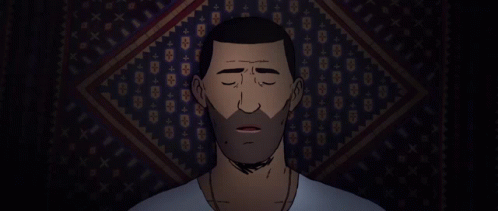

Quem pensa que animação é só coisa de criança está redondamente enganado e Flee é o melhor exemplo. A palavra Flee se traduz como fuga e esta é a história do documentário, a fuga de Amin Nawabi do Afeganistão para se refugiar na Dinamarca. A história começa na véspera do casamento de Amin com seu marido, com ele compartilhando pela primeira vez a sua história.
E sim, Flee é um documentário! Mais especificamente um docudrama, um gênero no qual a realidade é misturada com elementos de ficção. Por isso, além de melhor filme de animação, o filme também foi indicado nas categorias de melhor documentário e melhor filme em língua estrangeira, se tornando o filme de animação com o maior número de indicações em um mesmo ano.
Apesar de Flee ser relativamente simples com poucos personagens e pouca duração, não deixa de ser extremamente tocante. A jornada de Amin se descobrindo enquanto homem gay e tendo que largar sua pátria para poder sobreviver é contada com delicadeza e é impossível o espectador não se comover com a história.
Independente do resultado, todas as indicações de Flee foram muito merecidas e comprova que filmes animados são mais um meio para contar grandes histórias.
1 note
·
View note
Text
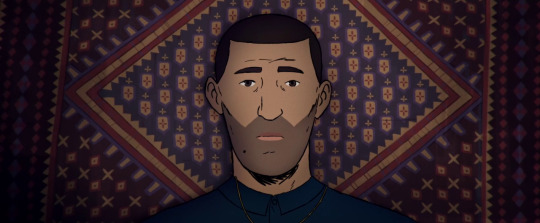
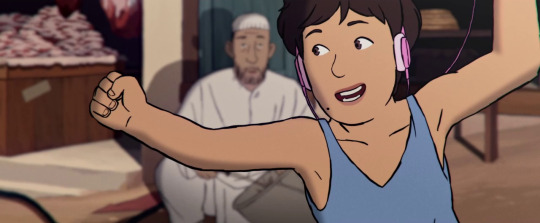
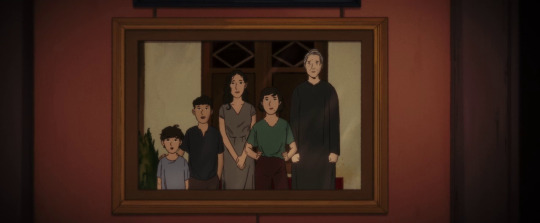
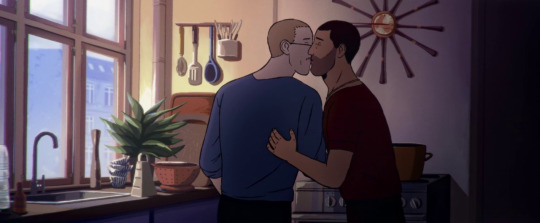
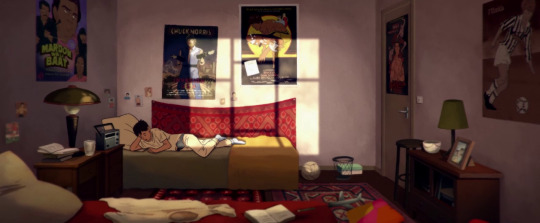
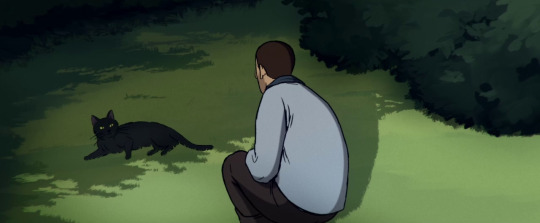
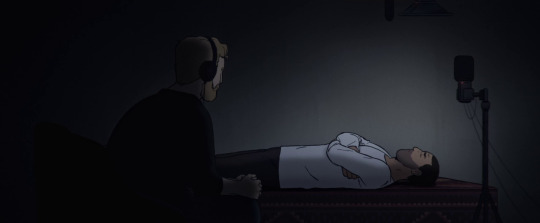
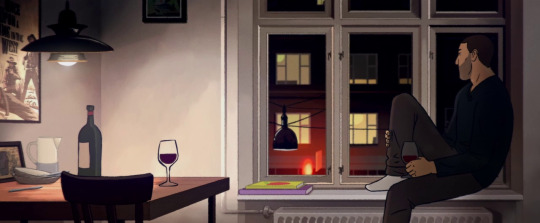
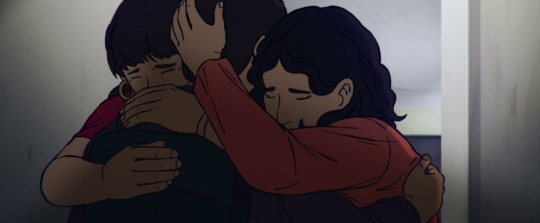
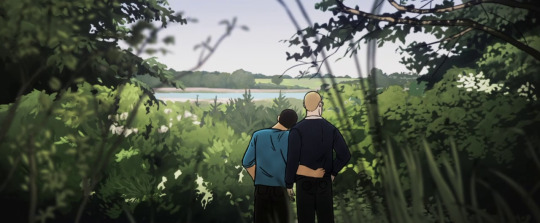
Flee (2021) | dir. Jonas Poher Rasmussen
447 notes
·
View notes
Text
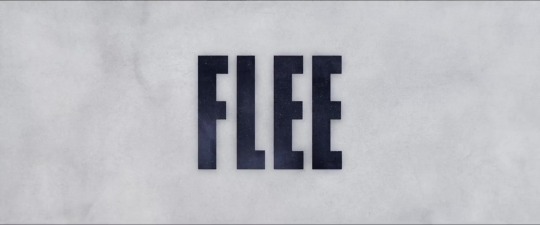
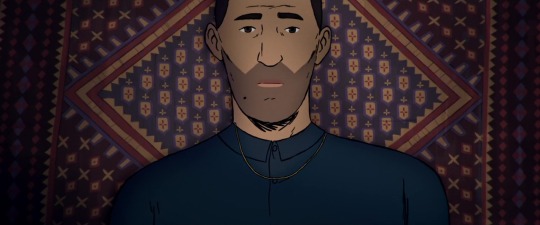

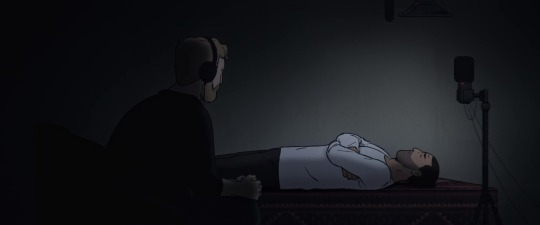
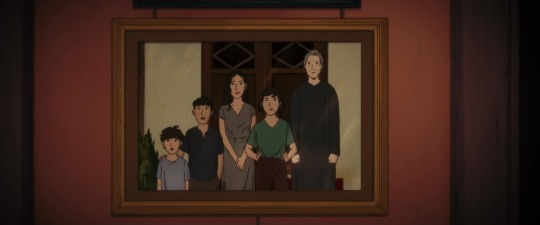
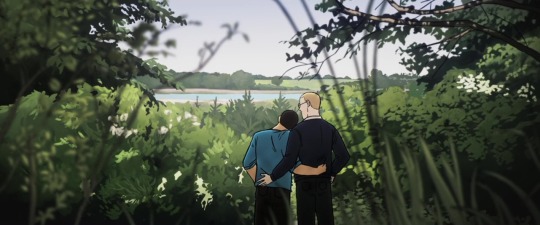
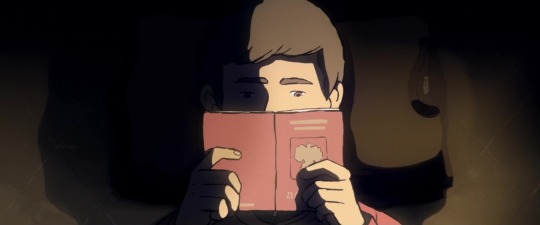
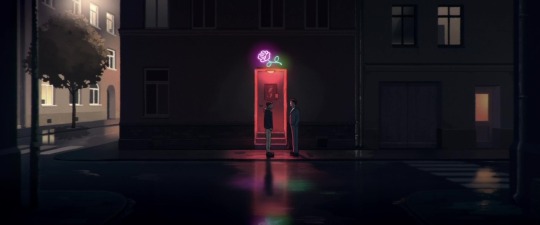
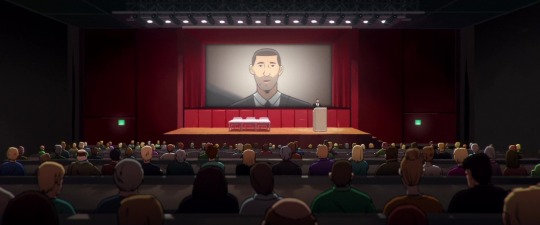
Flee (2021)
Director - Jonas Poher Rasmussen, Cinematography - Mauricio Gonzalez-Aranda
"I have no one. I'm all alone."
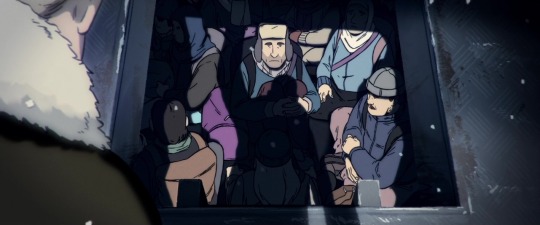
#scenesandscreens#flugt#amin nawabi#Daniel Karimyar#Fardin Mijdzadeh#flee#Mauricio Gonzalez-Aranda#Jonas Poher Rasmussen
82 notes
·
View notes
Text
Rookie-Critic's Top 20 Films of 2021: #5 - Flee (dir. Jonas Poher Rasmussen)

I don't normally watch many documentaries, and when I do they generally don't catch me in the same way that a lot of fictional films do, so going into Flee I wasn't sure what to expect. What I got was the story of an incredibly brave individual that, as a child, had to endure things that no child should have to endure, and surely not for as long as he had to. Told through an animated lens so as to protect the identity of the protagonist, who we only get to know as Amin Nawabi, Flee shows us what it's like to grow up knowing mostly uncertainty and fear. Framed as a series of interviews with Amin as an adult man in Denmark mere months away from marriage, Amin spends most of his childhood having to walk a tightrope alongside his family as they try to make it out of Afghanistan and into literally any other country where he thinks they'll be safe. Not only that, but Amin also has to navigate his growing awareness of his sexuality and how being gay affects his surroundings and possible standing within the only support system he thinks he'll ever have. It's a very disquieting film, because while Amin's story is ultimately one of relief, self-acceptance, and what things look like when someone actually gets out of a dangerous situation like that, it shines a light on the fact that Amin's story is just one of many, and so many of those other stories don't end as happily as his. Many people will see this as a heartwarming story, and not to take away from Amin's success, but I left the theater with angry tears in my eyes, crying for all of the refugees who didn't make it.
Score: 10/10
Currently available for streaming on Hulu.
2 notes
·
View notes
Photo

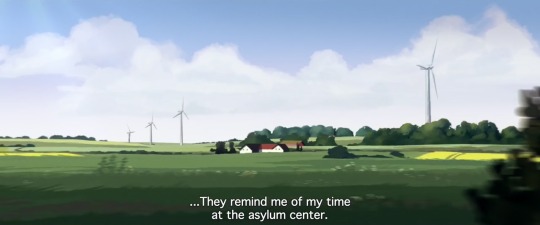
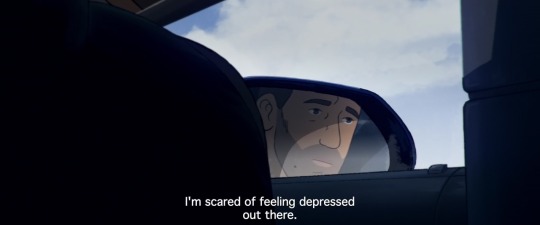
Flugt [Flee] (Jonas Poher Rasmussen - 2021)
#Flugt#Flee#drama film#Denmark#Afghanistan#refugees#Jonas Poher Rasmussen#European cinema#Riz Ahmed#life#Nikolaj Coster-Waldau#Amin Nawabi#2020s movies#history#war in Afghanistan#European society#self-discovery#past#unaccompanied minor#life story#Copenhagen#gay marriage#human trafficking#Kabul#Russia#1980s#1990s#Moskow#coming out#new york city
6 notes
·
View notes
Photo
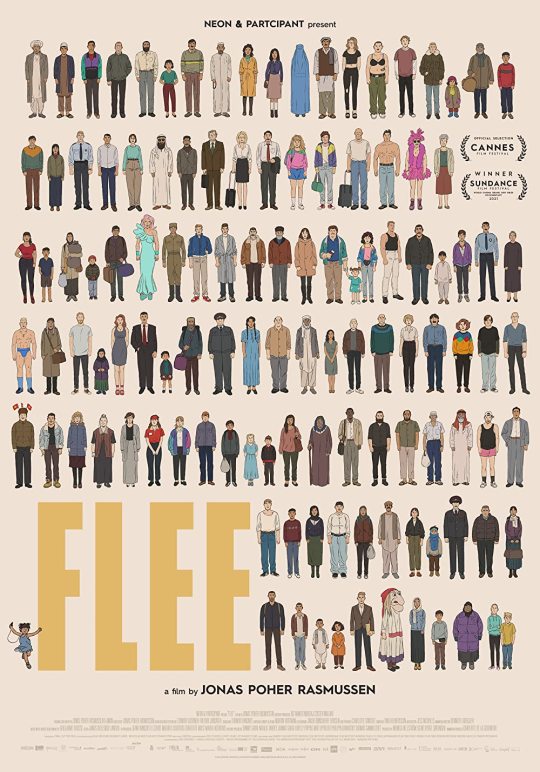
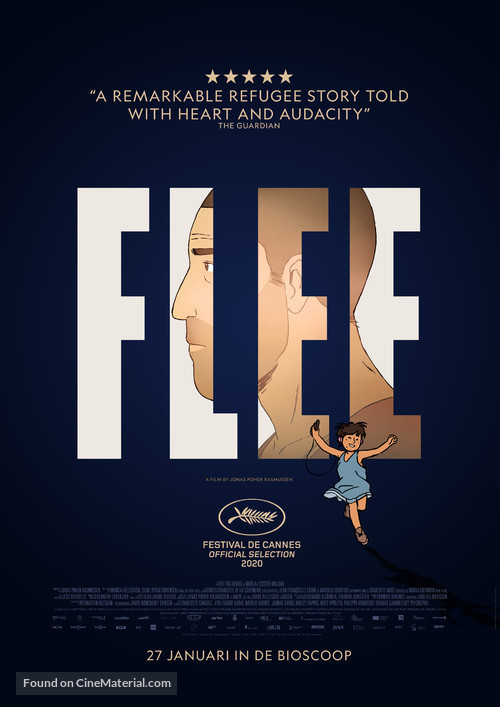
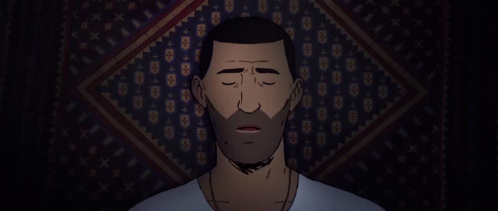
Top Picks of 2022
My Top 20 Favorite Movies - #17: Flee
Running Time: 90 minutes
Released: December 3rd, 2021
Watched It: February 2022
#Top Picks of 2022#My Top 20 Favorite Movies#Flee#Amin Nawabi#Jonas Poher Rasmussen#Riz Ahmed#Nikolaj Coster Waldau
3 notes
·
View notes
Photo
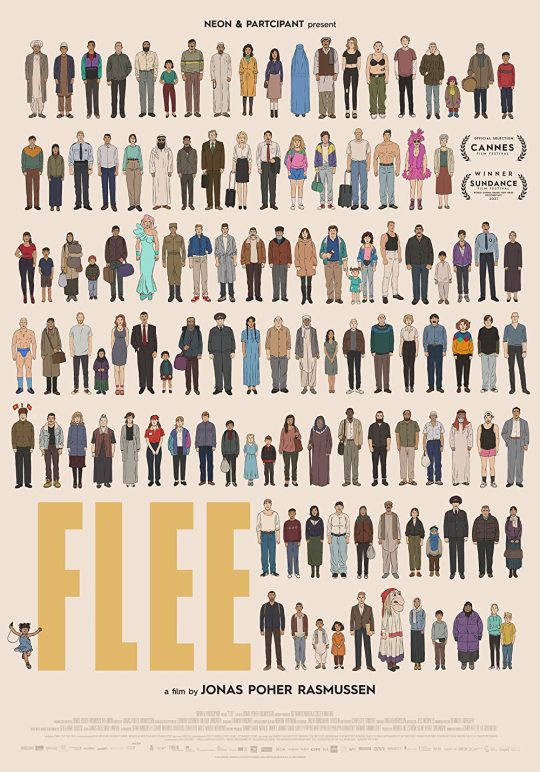
#flee#amin nawabi#daniel karimyar#fardin mijdzadeh#belal faiz#milad eskandari#zahra mehrwarz#elaha faiz#sadia faiz#jonas poher rasmussen#2021
4 notes
·
View notes
Text
Flee
Story: Ein animierter Dokumentarfilm, in dem der Filmemacher Jonas Poher Rasmussen die wahre Geschichte eines Mannes erzählt, der sich seiner Vergangenheit stellen muss, um wirklich eine Zukunft zu haben. Amin kam als unbegleiteter Minderjähriger aus Afghanistan nach Dänemark. Heute, mit 36 Jahren, ist er ein erfolgreicher Akademiker und heiratet gerade seinen langjährigen Freund. Ein Geheimnis,…

View On WordPress
#Afghanistan#Albtraum#Amin Nawabi#Animationsfilm#Charlotte de La Gournerie#Dokumentation#Drama#Flucht#Flüchtlinge#Gefängnis#Homosexualität#Identität#Jonas Poher Rasmussen#Lebensgeschichte#Menschenhandel#Monica Hellström#Scham#Signe Byrge Sørensen#Suche#Uno Helmersson#Vergangenheit#Wahrheit
0 notes
Text
Reseña | 'Flee: Huyendo de Casa'
'Flee: Huyendo de Casa' es un documental que utiliza la animación para conectar con la audiencia.
Cuenta la historia de Amin Nawabi mientras lidia con un doloroso secreto que mantuvo oculto durante 20 años, uno que amenaza con desbaratar la vida que construyó para sí mismo y su futuro esposo. Flee: Huyendo de Casa es una película que ha quedado marcada en la historia del Oscar y ni siquiera se llevó un premio, esto fue porque se convirtió en el primer documental en ser nominado a la categoría…
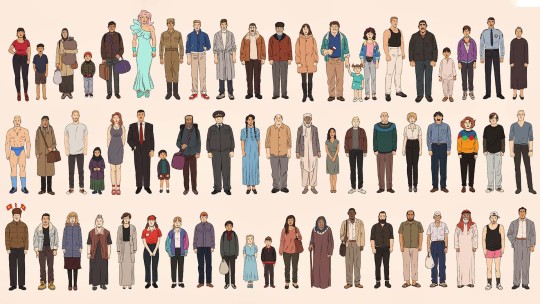
View On WordPress
0 notes